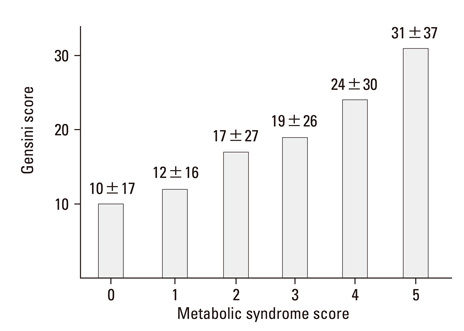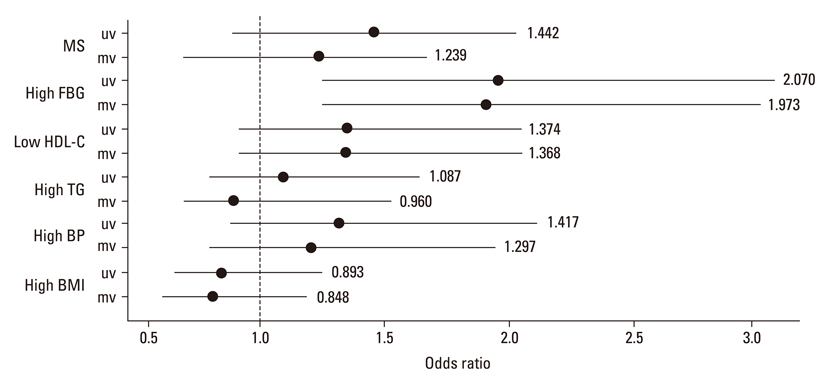Yonsei Med J.
2010 Sep;51(5):676-682. 10.3349/ymj.2010.51.5.676.
Impact of Metabolic Syndrome and Its Individual Components on the Presence and Severity of Angiographic Coronary Artery Disease
- Affiliations
-
- 1Cardiology Division, Department of Internal Medicine, Gangnam Severance Hospital, Yonsei University College of Medicine, Seoul, Korea. cardioblues@yuhs.ac
- KMID: 1071418
- DOI: http://doi.org/10.3349/ymj.2010.51.5.676
Abstract
- PURPOSE
Metabolic syndrome (MS) has been reported as a potential risk factor of coronary artery disease (CAD). The aims of this study were to assess whether there was a relationship between MS score and CAD angiographic severity, and to assess the predictive value of individual components of MS for CAD.
MATERIALS AND METHODS
We retrospectively enrolled 632 patients who underwent coronary angiography for suspected CAD (394 men, 61.0 +/- 10.6 years of age). MS was defined by the National Cholesterol Education Program criteria with the waist criterion modified into a body mass index (BMI) of more than 25 kg/m2. The MS score defined as the number of MS components. CAD was defined as > 50% luminal diameter stenosis of at least one major epicardial coronary artery. CAD angiographic severity was evaluated with a Gensini scoring system.
RESULTS
Of the patients, 497 (78.6%) had CAD and 283 (44.8%) were diagnosed with MS. The MS score was significantly related to the Gensini score. High fasting blood glucose (FBG) was the only predictive factor for CAD. A cluster including high FBG, high blood pressure (BP), and low high-density lipoprotein cholesterol (HDL-C) showed the highest CAD risk.
CONCLUSION
The MS score correlates with the angiographic severity of CAD. The predictive ability of MS for CAD was carried almost completely by high FBG, and individual traits with high BP and low HDL-C may act synergistically as risk factors for CAD.
MeSH Terms
Figure
Reference
-
1. Reaven GM. Banting lecture 1988. Role of insulin resistance in human disease. Diabetes. 1988. 37:1595–1607.
Article2. James PT, Rigby N, Leach R. International Obesity Task Force. The obesity epidemic, metabolic syndrome and future prevention strategies. Eur J Cardiovasc Prev Rehabil. 2004. 11:3–8.
Article3. Jørgensen ME, Borch-Johnsen K. The metabolic syndrome--is one global definition possible? Diabet Med. 2004. 21:1064–1065.
Article4. Ford ES. Risks for all-cause mortality, cardiovascular disease, and diabetes associated with the metabolic syndrome: a summary of the evidence. Diabetes Care. 2005. 28:1769–1778.
Article5. Galassi A, Reynolds K, He J. Metabolic syndrome and risk of cardiovascular disease: a meta-analysis. Am J Med. 2006. 119:812–819.
Article6. Gami AS, Witt BJ, Howard DE, Erwin PJ, Gami LA, Somers VK, et al. Metabolic syndrome and risk of incident cardiovascular events and death: a systematic review and meta-analysis of longitudinal studies. J Am Coll Cardiol. 2007. 49:403–414.
Article7. Solymoss BC, Bourassa MG, Lespérance J, Levesque S, Marcil M, Varga S, et al. Incidence and clinical characteristics of the metabolic syndrome in patients with coronary artery disease. Coron Artery Dis. 2003. 14:207–212.
Article8. Iribarren C. The metabolic syndrome is no better than its components. Minerva Cardioangiol. 2007. 55:487–489.9. Wang J, Ruotsalainen S, Moilanen L, Lepistö P, Laakso M, Kuusisto J. The metabolic syndrome predicts cardiovascular mortality: a 13-year follow-up study in elderly non-diabetic Finns. Eur Heart J. 2007. 28:857–864.
Article10. Solymoss BC, Bourassa MG, Campeau L, Sniderman A, Marcil M, Lespérance J, et al. Effect of increasing metabolic syndrome score on atherosclerotic risk profile and coronary artery disease angiographic severity. Am J Cardiol. 2004. 93:159–164.
Article11. Azevedo A, Bettencourt P, Almeida PB, Santos AC, Abreu-Lima C, Hense HW, et al. Increasing number of components of the metabolic syndrome and cardiac structural and functional abnormalities--cross-sectional study of the general population. BMC Cardiovasc Disord. 2007. 7:17.12. Expert Panel on Detection, Evaluation, and Treatment of High Blood Cholesterol in Adults. Executive Summary of The Third Report of The National Cholesterol Education Program (NCEP) Expert Panel on Detection, Evaluation, And Treatment of High Blood Cholesterol In Adults (Adult Treatment Panel III). JAMA. 2001. 285:2486–2497.13. National Cholesterol Education Program (NCEP) Expert Panel on Detection, Evaluation, and Treatment of High Blood Cholesterol in Adults (Adult Treatment Panel III). NCEP) Expert Panel on Detection, Evaluation, and Treatment of High Blood Cholesterol in Adults (Adult Treatment Panel III). Third Report of the National Cholesterol Education Program (NCEP) Expert Panel on Detection, Evaluation, and Treatment of High Blood Cholesterol in Adults (Adult Treatment Panel III) final report. Circulation. 2002. 106:3143–3421.14. Grundy SM. Hypertriglyceridemia, atherogenic dyslipidemia, and the metabolic syndrome. Am J Cardiol. 1998. 81:18B–25B.
Article15. Genuth S, Alberti KG, Bennett P, Buse J, Defronzo R, Kahn R, et al. Follow-up report on the diagnosis of diabetes mellitus. Diabetes Care. 2003. 26:3160–3167.
Article16. Matthews DR, Hosker JP, Rudenski AS, Naylor BA, Treacher DF, Turner RC. Homeostasis model assessment: insulin resistance and beta-cell function from fasting plasma glucose and insulin concentrations in man. Diabetologia. 1985. 28:412–419.
Article17. Friedewald WT, Levy RI, Fredrickson DS. Estimation of the concentration of low-density lipoprotein cholesterol in plasma, without use of the preparative ultracentrifuge. Clin Chem. 1972. 18:499–502.
Article18. Gensini GG. A more meaningful scoring system for determining the severity of coronary heart disease. Am J Cardiol. 1983. 51:606.
Article19. Grundy SM, Cleeman JI, Daniels SR, Donato KA, Eckel RH, Franklin BA, et al. Diagnosis and management of the metabolic syndrome: an American Heart Association/National Heart, Lung, and Blood Institute Scientific Statement. Circulation. 2005. 112:2735–2752.20. Kahn R, Buse J, Ferrannini E, Stern M. American Diabetes Association. European Association for the Study of Diabetes. The metabolic syndrome: time for a critical appraisal: joint statement from the American Diabetes Association and the European Association for the Study of Diabetes. Diabetes Care. 2005. 28:2289–2304.
Article21. Clemenz M, Kintscher U, Unger T. The metabolic syndrome: cluster with a self-fulfilling loop? J Hypertens. 2006. 24:257–258.
Article22. Greenland P. Critical questions about the metabolic syndrome. Circulation. 2005. 112:3675–3676.
Article23. Stern MP, Williams K, González-Villalpando C, Hunt KJ, Haffner SM. Does the metabolic syndrome improve identification of individuals at risk of type 2 diabetes and/or cardiovascular disease? Diabetes Care. 2004. 27:2676–2681.
Article24. McNeill AM, Rosamond WD, Girman CJ, Golden SH, Schmidt MI, East HE, et al. The metabolic syndrome and 11-year risk of incident cardiovascular disease in the atherosclerosis risk in communities study. Diabetes Care. 2005. 28:385–390.
Article25. Golden SH, Folsom AR, Coresh J, Sharrett AR, Szklo M, Brancati F. Risk factor groupings related to insulin resistance and their synergistic effects on subclinical atherosclerosis: the atherosclerosis risk in communities study. Diabetes. 2002. 51:3069–3076.26. Hassinen M, Komulainen P, Lakka TA, Väisänen SB, Haapala I, Gylling H, et al. Metabolic syndrome and the progression of carotid intima-media thickness in elderly women. Arch Intern Med. 2006. 166:444–449.
Article27. Wannamethee SG, Shaper AG, Lennon L, Morris RW. Metabolic syndrome vs Framingham Risk Score for prediction of coronary heart disease, stroke, and type 2 diabetes mellitus. Arch Intern Med. 2005. 165:2644–2650.
Article28. Sattar N, McConnachie A, Shaper AG, Blauw GJ, Buckley BM, de Craen AJ, et al. Can metabolic syndrome usefully predict cardiovascular disease and diabetes? Outcome data from two prospective studies. Lancet. 2008. 371:1927–1935.
Article29. Marquis K, Maltais F, Duguay V, Bezeau AM, LeBlanc P, Jobin J, et al. The metabolic syndrome in patients with chronic obstructive pulmonary disease. J Cardiopulm Rehabil. 2005. 25:226–232.
Article30. Bonora E, Targher G, Formentini G, Calcaterra F, Lombardi S, Marini F, et al. The Metabolic Syndrome is an independent predictor of cardiovascular disease in Type 2 diabetic subjects. Prospective data from the Verona Diabetes Complications Study. Diabet Med. 2004. 21:52–58.31. Meigs JB, Wilson PW, Fox CS, Vasan RS, Nathan DM, Sullivan LM, et al. Body mass index, metabolic syndrome, and risk of type 2 diabetes or cardiovascular disease. J Clin Endocrinol Metab. 2006. 91:2906–2912.
Article32. McLaughlin T, Abbasi F, Lamendola C, Reaven G. Heterogeneity in the prevalence of risk factors for cardiovascular disease and type 2 diabetes mellitus in obese individuals: effect of differences in insulin sensitivity. Arch Intern Med. 2007. 167:642–648.
Article33. Park HS, Park CY, Oh SW, Yoo HJ. Prevalence of obesity and metabolic syndrome in Korean adults. Obes Rev. 2008. 9:104–107.
Article
- Full Text Links
- Actions
-
Cited
- CITED
-
- Close
- Share
- Similar articles
-
- Differential Relationship between Metabolic Syndrome Score and Severity of Coronary Atherosclerosis as Assessed by Angiography in a Non-Diabetic and Diabetic Korean Population
- Moderating effect of Lifestyle and Type D personality on the Relationship between Metabolic Syndrome and Severity of Coronary Artery Disease
- Coronary arterial disease associated with arteriosclerosis in lower extremity: angiographic analysis
- Severity of Coronary Atherosclerosis; Influence of Metabolic Syndrome Risk Factor Clustering and hs-CRP
- Relationship between Metabolic Syndrome and Coronary Heart Disease in Elderly



